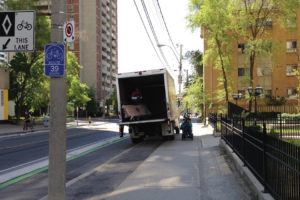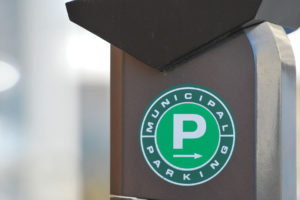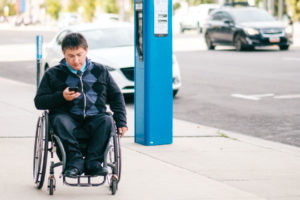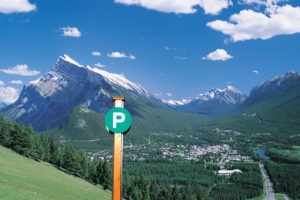Smart Cities are the way of the future. Every city in Canada is already planning its evolution into a Smart City and some are beginning to implement the initial elements.
The success of this evolution will depend largely on parking technology. Drivers—and eventually those in autonomous vehicles—need to park, and making it easier to park will dramatically reduce congestion on city streets. In the not-too-distant-future, when we leave the house, we’ll just enter our destination into our car’s GPS and then the car will guide us directly to the closest available parking space to that destination. If we haven’t already reserved and paid for a parking space in advance, we’ll be able to pay with our cell phones. If we need more time than we paid for, we’ll get a text reminding us when it’s time to move the car and asking if we want to pay for more parking—which we can do with our cell phones, without returning to the car.
The Foundation of Smart Cities
Intelligent parking technology will play the key role. Intelligent parking uses parking guidance sensors located in or over parking spaces to monitor whether they are occupied or available, and transmits that information to strategically located signs to guide vehicles directly to available spaces.
Parking guidance is already common in parkades throughout Canada. While it’s primarily used as a driver amenity designed to make it easier to quickly and conveniently find an available parking space, it also helps parking organizations better manage their assets by providing real-time data about how those assets are being utilized. Additionally, parking guidance also helps organizations increase their occupancy by eliminating the risk that drivers will give up looking for a space and…
Over the last decade, an overwhelming amount of literature has been produced in the public transportation field regarding Millennials and the future of personal vehicle ownership, and therefore the future of Municipal Parking lots. Most of the research indicates that Millennials are generally less car-focused than previous generations, and their transportation behaviours continue to change in ways that ultimately reduce personal vehicle driving. There are plenty of reasons that have contributed to this ‘shift’ in behaviour, including: dependence on technology, socioeconomic contributors (delayed marriage, the Recession), and lifestyle preferences (Millennials tend to prefer walkable communities). Recent studies and dialogues surrounding Smart Cities suggest City Planners are beginning to ‘rethink parking…by getting rid of it.’ At the centre of the dialogue surrounding the future of parking in cities is an assumption that Millennials apprehensiveness to drive and own private vehicles. This will predict future travel behaviours by them, and generations to come.
Re-thinking parking by getting rid of it is not only short-sighted but does not fully take into consideration the travel patterns of Millennials. While some Millennials have certainly chosen to fore-go vehicle ownership, particularly in dense urban centres like downtown Toronto, Millennials surrounding the GTA in less dense cities, for example Mississauga, are still choosing to use a personal vehicle to move around.
While the technology surrounding self-driving cars is in place, and continues to evolve, the governing regulations surrounding self-driving cars are still in their infancy. Self-driving cars may eventually reduce parking demand considerably and will certainly change the way users pay for parking. It is reasonable that there be an emphasis on ensuring all future parking garages must be built in a manner that would allow for ‘future-proofing’ for self-driving cars, or to accommodate other uses if there…
By Peter Richards, IBI Group
Introduction
IBI Group worked with the City of Toronto on the Curbside Management Strategy. The City of Toronto has seen and continues to experience significant growth with substantial development adjacent to its right-of-way, resulting in considerable demands on the road network and excessive congestion; especially in the downtown core. Currently, curbside access (use of the shared space on a roadway adjacent to the sidewalk) is in high demand for motorists, cyclists, operators of transit, taxi, motor coach, courier and other deliveries/goods movement vehicles, and many other users.
The Curbside Management Strategy’s objective is to improve upon the efficiency and effectiveness of curbside space allocation and usage for all parking and loading activity, and to reduce congestion in the study area. The study area is bounded by Lake Shore Boulevard / Harbour Street, Bathurst Street, Queen Street, and Jarvis Street in Toronto. Between University Avenue and Yonge Street, the Study Area extends northerly to Dundas Street.
Activities under the Curbside Management Strategy (CMS) will help manage traffic congestion by:
- Using innovative solutions to improve the balance of safe access for people and goods with mobility;
- Reducing illegal parking which may affect traffic flow; and
- Increasing legal parking availability and reducing parking “search time” (i.e., cruising).
The CMS study involved the following overall tasks – reviewing of existing conditions, assessing future condition impacts, outreach and stakeholder engagement, reviewing best practices, developing strategies to evaluate, and recommending a set of policies and a proposed implementation plan.
Existing Conditions Review
The objective of the Existing Conditions review was to study the existing transportation conditions and curbside usage, issues, and opportunities in downtown Toronto within the proposed study area. This included a high-level review of existing City of Toronto policies and commitments, to ensure adherence and consistency for any potential recommendations. Some significant issues…
Torontonians wanted an app for parking — and they got it
By Stacy Sneed
One of the fastest growing cities in North America, Toronto is a hub for the design, finance, science and media industries. The city is also known for its tech savviness and app usage. In 2016, the latest report by Yahoo Canada! shared that Canadian app use grew by an average rate of 74 percent, far exceeding the global average of 11 percent. In fact, the number of Canadian devices exceeds the estimated number of Canadians by more than 2 million. What this signifies is that people in Toronto enjoy the ease and convenience apps add to their lives. When citizens become accustomed to the advantages that apps provide, they want to have access in every part of their lives … including interactions with their local government.
As this growing metropolitan area reached over 6 million residents in 2014, it faced increased congestion and traffic. Finding parking in Toronto became a hassle for drivers, and parking payment options were limited. Drivers either had to have cash available for meters or use their credit cards at a pay station. The Toronto Parking Authority (TPA) realized that point of frustration for drivers, and saw an opportunity to offer a better way to pay for parking. TPA issued a request for proposal (RFP) for mobile pay providers in 2014 in an effort to improve the overall parking experience around the city.
“The choice to go with a mobile app was heavily driven by our customers. We also wanted to provide an operational cost savings with it,” said Ian Maher, TPA’s vice president of strategic planning and I.T.
TPA sought a solution to implement technology and make local trips faster and easier. In order to achieve that, the…
By Renee Smith, JD MBA
Canada’s cities have long struggled with how to make their streets (and sidewalks and neighborhoods) more accessible to people with disabilities. There are many barriers to handicap access, including curbs bordering sidewalks, paucity of parking spaces designated solely for use by people with disabilities, and inaccessible buses and other forms of public transportation for people who don’t want to drive into the heart of the city. Add to that snow drifts, which are a common presence on our streets and sidewalks, and it’s easy to understand why it can be so difficult for people with disabilities to often struggle in our cities.
One area where cities sometimes fall short when it comes to accessibility is parking. That’s because it’s easy to fall into the trap of only addressing the most obvious accessibility issues, such as the size and location of parking spaces for people with disabilities. These are obviously important issues, but they only address part of the issue.
For many cities accessibility often ends at the curb cut. Parking planners tend to do a good job of making it easy to find appropriate parking and get safely out of vehicles and onto sidewalks. However, they don’t always give as much thought to their parking equipment, particularly meters and parking payment machines.
Impossible To Use
Not all parking equipment is designed with the needs of people with disabilities in mind, and older equipment can be particularly problematic. It’s often too tall or poorly designed for them to use, particularly those in wheelchairs. With the advent of pay-on-foot systems and smart meters, payment kiosks have become a common sight in cities. Unfortunately drivers with disabilities, particularly those in wheelchairs, sometimes can’t use these meters and kiosks because the credit card slots and cash receptacles in the equipment…
An interview with Shawn Skrine
By gtechna
In advance of this year’s Canadian Parking Association Conference held in Banff, Alberta, Banff’s Shawn Skrine sat down with gtechna, a Montreal-based eCitation and parking software company, for an interview that revealed some interesting points about what exactly makes a city “smart”.
Banff is a resort town located inside a national park, which means it has a small number of permanent residents and a seasonal population that fluctuates widely. Embracing cutting-edge parking technology has allowed Banff to easily accommodate the annual influx of tourist traffic; a great reminder that being a smart city is more about innovation than population!
Can you describe for us what parking is like in Banff?
We have five full time enforcement officers and in the summer, two to three seasonal officers. Our officers use two vehicles and two bikes to patrol roughly 2,000 spaces that we have downtown.
We have several surface lots, one four-story parking structure, and a good deal of street parking. All of our parking is time-limited, but free.
How does Banff’s high volume of tourists affect the parking situation?
To be honest with you, it’s more of the locals that were affected when we started implementing time-limit parking than it was the tourists, because tourists seem to look for signs.
We started time-limiting the parking to change behavior, which seems to have happened. Now after three years, there’s been about a 30% increase in time-limit compliance. The number of tickets issued for time-limit offences has been reduced and downtown parking turnover has improved, which is what we wanted.
What are the rules you use for time-limited parking?
It varies. Our zones range from 15-minute limits all the way to nine-hour limits. Streets usually have either two-hour or 15-minute limits, parking lots are all three hours, the parking structure has two-hour and eight-hour spaces, and there are…
By Chelsea Webster
Let’s start the first mile of this journey by setting a goal for reading this article: learning what first mile and last mile means in relation to transportation, and finding ways for the parking industry to embrace (and maybe even capitalize) on this growing urban challenge.
The Rise of Public Transit
If you live in a city, you likely understand that public transit is an important part of city life. As more of the world’s population moves into cities, and cities aren’t able to accommodate the demand for individual cars and parking, transit will continue to grow in importance. There are lots of articles already touting that the personal vehicle is falling as king of transportation. As this process happens, it will be even more critical to make taking alternate methods of transportation as easy as possible.
If you’ve ever tried to take public transportation, you’re likely aware of a big setback inherent in any transit system: it doesn’t come right to your door.
So, if people aren’t willing to walk to the “nearest” transit stop, but still want to take the train or subway or express bus, how do they get to that transit stop? The process is called first mile (getting from your house or starting point to the transit stop) and last mile (getting from where transit lets you off to your actual destination) commuting.
We Love Our Cars
Thanks to the automobile revolution, we’ve seen the personal vehicle have a massive economic impact. Highways were built, automotive factories churned out vehicles of all sorts, and a whole new parking industry sprang up – all of which created hundreds of thousands of jobs in Canada and the US. With the ability for the average person to own a vehicle, people had the freedom to live and travel to places previously…
Parking Excellence Recognized in Canada (PERC), later updated to the Parking Facility Standards Award program (PFSA) was the first parking facility evaluation program of its kind, and saw many Canadian parking organizations achieve success through participation in the program.
Derived from these past award programs, a standard checklist of items required to meet acceptable, minimum standards for a parking facility has been further amended and endorsed by the Canadian Parking Association as the benchmark for measuring a facility against national standards.
The objective of sharing this check list is to provide the tools necessary for operators to self-check their parking facilities against minimum requirements to manage and maintain a quality parking operation that sets it above others, and helps to improve the image of the industry. The standards cover a variety of facility types, from gravel lots to state-of-the-art parkades, both old and new.
Through a comprehensive consultative process involving a team of parking professionals representing the municipal, airport, campus, private, and hospital sectors, a set of criteria emerged. The CPA’s Image Committee, comprised of board members from all Canadian sectors, worked in consultation with members from all regions of the country during various stages of development.
Focus groups were conducted in five major cities across Canada: Vancouver, Calgary, Toronto, Montreal and Saint John. More than 300 participants from a range of community sectors were asked to share current and relevant information about their experiences using parking facilities.
Keeping in mind that this study was conducted prior to the technological boom that has evolved and transformed the industry over the past decade, the study’s main focus at the time was on the physical state of the parking facilities and the level of customer service provided to enhance the parking experience. Despite the development and introduction of new technology, maintaining standards in all aspects of…
The WPA offers residential parking permits which provide residents the ability to park in their specific residential zone and are required to obey all traffic by-laws, including all annual snow route bans, residential parking bans, and public works street works signs for spring and fall street cleaning.
Residential Parking Programs help communities manage non-resident vehicles in their neighbourhood by restricting the amount of time non-residents can park.
The WPA is interested in the following:
- if other cities provide such a permit
- if the permit is a monthly or annual permit
- the cost associated with the permit,
- and if the permit is prorated from the time of purchase
Donna Olson | Winnipeg Parking Authority | dolson@winnipeg.ca
Have other municipalities put out an RFI or an RFP with regards to Parking infrastructure review? We’d like to find a consultant to review our entire parking operation (on and off street parking, including meters, surface lots, garages, residential, our monthly permit process, our ticketing process, and our summonsing process). We’d like to have someone knowledgeable with current technology and trends who can provide some unbiased, non-vendor advice on where we should be going and why.
How have other municipalities gone about the process of finding a consultant, what results they expected, what results they actually received, and whether the exercise had positive results for them?
Kris McGuire, Operations Assistant / Préposé aux opérations
Parking Services / Services de stationnement
City of Fredericton / Ville de Fredericton
Ph: 506-460-2798 | E-mail: kris.mcguire@fredericton.ca










